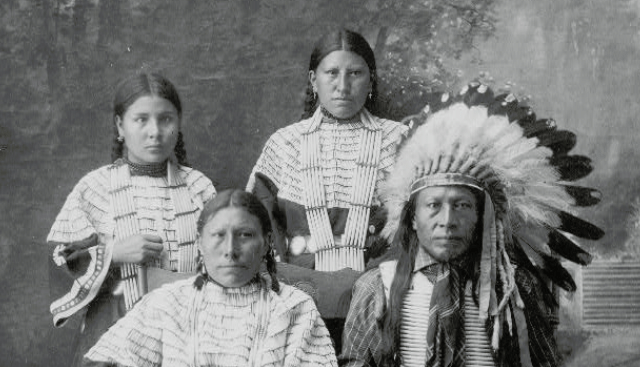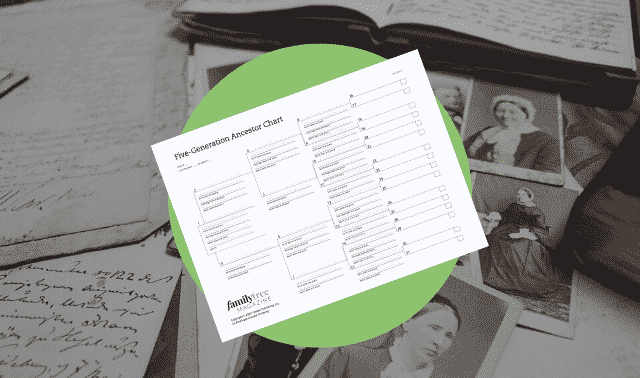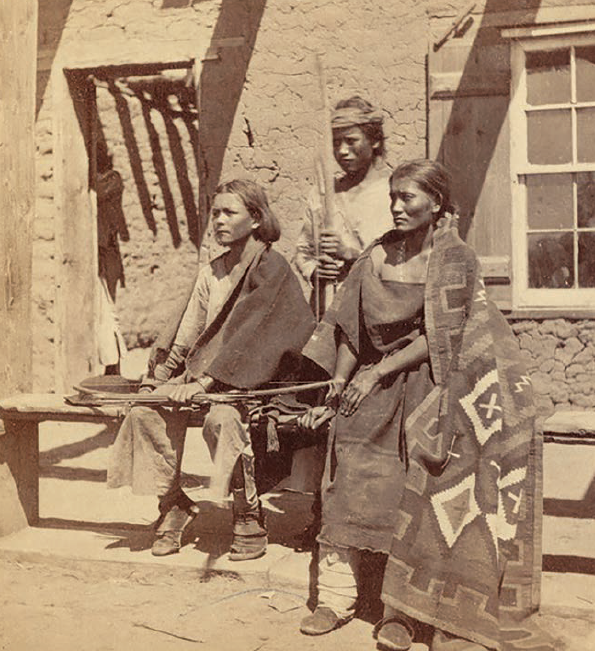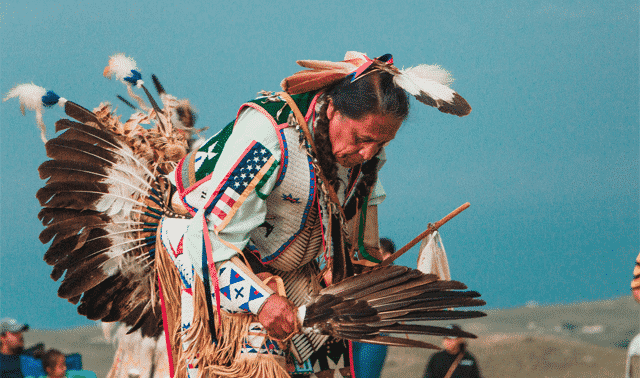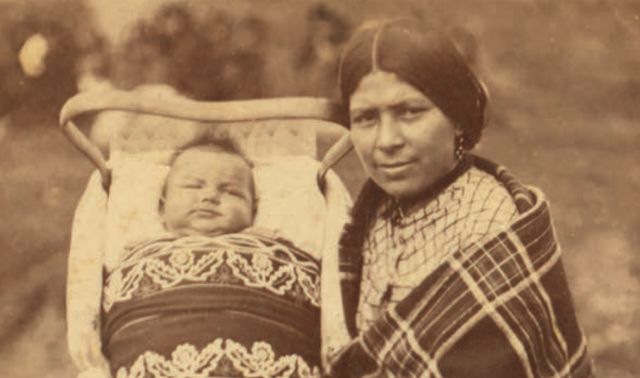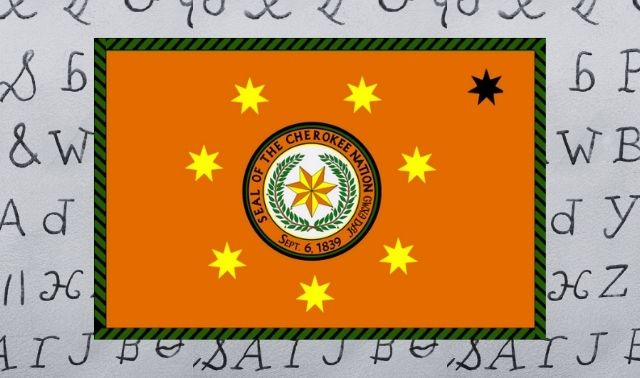Sign up for the Family Tree Newsletter Plus, you’ll receive our 10 Essential Genealogy Research Forms PDF as a special thank you!
Get Your Free Genealogy Forms
"*" indicates required fields
In this article:
- Who Are the Five Tribes?
- Tribal Languages and Naming Traditions
- Geography
- Special Censuses and the Dawes Rolls
- Tribe-Specific History and Resources
- Other Resources for Researching Native Ancestors
- Social History
For thousands of years, North America has been inhabited by a wide variety of peoples with a variety of language groups, living styles, and family and tribal structures. And cultural values like deep spirituality and survival skills have helped them well into modern times.
With such diverse cultures and populations among indigenous groups in particular, it can be difficult to know where to begin learning about your ancestors. This is especially true if you don’t have the name of a tribe, or are basing your research off vague (or worse, terribly inaccurate) family stories about Native ancestry.
To help get you started, this article shares information on researching ancestors who were part of the five largest contemporary tribes: Navajo, Cherokee, Sioux, Chippewa and Choctaw. Each of the seven lessons that follow will help you better understand the cultural context for genealogy research of those tribes, and share some resources for finding records.
Who Are the Five Tribes?
Tribal groups were often referred to in a variety of ways in records. Europeans generally had their own names for tribes (some of them derogatory), spelled phonetically based on what they heard from Native speakers.
Because of this, many of the names we associate with tribes today are exonyms and weren’t how the tribes originally called themselves. In fact, they may literally mean “enemy” or another negative term. For example, “Sioux” is actually the Ojibwe word for “snakes”; Europeans picked up the name from the Sioux’s rival tribe.
As a result, broaden your search in records for the names that tribes actually used to refer to themselves, many of them translating to “the People” or “our family”:
- Navaho/Navajo: Diné
- Cherokee: Tsalagi or Aniyunwiya
- Sioux: Lakota, with language dialects referenced as Lakota, Nakota or Dakota
- Chippewa: Ojibwa
- Choctaw: Choctah or Chahta
As indigenous peoples had strong oral traditions, written versions of their names didn’t begin to emerge until missionaries, settlers, military leaders and government officials began referencing groups beginning from early settlements. With more-recent efforts to reclaim languages and culture from decades of oppression and abuse, language-learning in tribal schools and sovereign tribal governments are using these names more.
Editor’s note: The five tribes discussed in this article do not comprise the group historically referred to as the “Five Civilized Tribes.” Those tribes were the Cherokee and Choctaw (discussed below) as well as the Chickasaw, Creek and Seminole.
Tribal Languages and Naming Traditions
In many tribal families, individual people and ancestors have several names. Birth names are the first that an individual may hold, with inherited names or names representing a person’s character or notable ceremonial moments added to the list over time. You can sometimes use these naming patterns to reconstruct family histories, useful since European-style surnames were not generally part of tribal history. Note that some names may have only been used in spiritual ceremonies.
Further, people may have Anglicized names that are separate (or translated from) the native language. The use of either Native or English names (or both) can indicate fluency in the tribal language (or lack thereof), interaction with systems beyond the tribal culture, or overall connection to the tribe.
Note that many tribal groups have all but lost their original languages due to disease, massacres, government interference, or the pressures of assimilation. Native language use in the United States reflects population numbers, culture, geography and more. Navaho (Diné) is the most widely spoken, but other languages (in descending order of usage) include Sioux (Lakota, Nakota, Dakota dialects), Yupik (spoken largely by peoples in Alaska), O’odham (in Arizona and Mexico), Apache (in the American Southwest), Keresan (in New Mexico), Cherokee (Tsalagi)/Aniyunwiya) and Choctaw (Chochta/Chahta).
Geography
Once you’ve identified your ancestor’s tribe and name, you’ll next need to understand where they lived. All tribal groups were negatively impacted by forced removals and relocations from ancestral homelands, meaning your ancestors likely lived in different places during different time periods.
What differs between tribes are the timelines, with eastern tribes generally experiencing relocation earlier than tribes in the Midwest or West. Some occurred during intertribal wars, while others came at the hands of the US government. Notable dates for the five tribes we’re covering include 1830, the passage of the Indian Removal Act that was largely responsible for the Trail of Tears removal of the Cherokee and Choctaw.
The site Native Land has a zoomable map of the Americas that allows you to view a location and what tribes historically lived there. You can filter by language or territory, and even toggle treaties that ceded land from tribes to the US government.
Special Censuses and the Dawes Rolls
As in non-Native research in the United States, federal and state censuses are critical resources when doing Native research. These documents, often kept at regular intervals, place your ancestors in a particular place at a particular time.
This is true for researching indigenous ancestors as well. Start from yourself and work backward in time, looking at each decennial federal census and any state or territorial censuses that your ancestor would have been mentioned in.
Of special note are the Indian schedules in the 1900 and 1910 censuses. The unique sections at the bottom of these pages entitled “Special Inquiries Relating to Indians” provide details that may help you not only place your ancestors within Native territories or lands, but give you the name of their tribal affiliations. Pay particular attention to compilations that provide the “Indian” name and the English name.
The Constitution specifies that the census would exclude “Indians not taxed” (i.e., those who weren’t levied with taxes and lived either on government land or in unsettled territory). As a result, Native people were largely excluded from the federal census until at least 1860.
However, in addition to the decennial census, the Bureau of Indian Affairs was required to take annual censuses of Native communities across the country. FamilySearch has compiled many of those enumerations into one searchable collection, with years ranging from 1885 to 1940. Note that not all communities were represented, and (as of writing) the FamilySearch collection isn’t fully indexed. AccessGenealogy lists the various censuses by reservation or agency, and the National Archives provides a good primer.
And finally, the Dawes Commission Enrollment Rolls (“Dawes rolls”) cover two of the tribes we discuss in this article (the Cherokee and Choctaw), as well as the Chickasaw, Creek and Seminole. This enumeration was taken in Indian Territory—that is, modern Oklahoma—between 1898 and 1914. Through the rolls, the US government sought to allocate land to individual tribe members, then open the rest to settlement by non-Native peoples. Each entry includes a host of documents useful for family history research: census cards, an application including vital records, and letters.
You can find the Dawes rolls through a variety of websites including the National Archives and Records Administration and the Oklahoma History Society.
Tribe-Specific History and Resources
Some big genealogy websites (such as Ancestry.com and FamilySearch) are bound to have resources useful to Native research regardless of tribe, as does AccessGenealogy. But with differing histories and geographies, each of the five tribes we discuss in this article will have different record sets and websites that researchers should use. What follows are quick summaries of each tribe’s history and territory, plus resources specific to each.
The Navajo/Diné
The largest tribal group in terms of both population and land mass (i.e., organized territory or “reservation”) is the Navajo/Diné. Their territory is Navajo Nation in Arizona, New Mexico and parts of southern Utah—an area 10 times larger than the next-largest Native territory, and larger than 10 US states. Their extensive territory includes a tribal government centered in Window Rock, Ariz., plus a network of agencies and chapters that serve members across the vast region.
The forced removal of this tribe from their lands in the 1860s is called “the Long Walk.” After an 1868 treaty, the US government allowed members to return to tribal lands, making this unique in US history. In fact, Navajo territory is notable for being one of the few indigenous territories still held by its original residents.
Special censuses for Navajo populations were taken from 1929 to 1935 and are included in the Indian census rolls we discussed earlier (1885–1940).
Cherokee/Tsalagi Nations
The second-largest tribal group, the Cherokee or Tsalagi, were part of the “Trail of Tears” forced removal from the southeast, which also included the Choctaw/Chochta (the fifth-largest group), Chickasaw, Seminole and Creek. While much has been written about the thousands removed from their lands, some tribal people did escape this horror by hiding in the remote territories of this region.
Modern tribal governments are now headquartered in Oklahoma and (reflecting the Cherokee who remained in the east) North Carolina. The Cherokee Nation of Oklahoma in Tahlequah, Okla., has a heritage center, genealogy research information and more.
Also in Tahlequah is the headquarters of the United Keetoowah Band in Oklahoma (a separate tribe from the Cherokee Nation). The Eastern Band of Cherokee Indians is located in Cherokee, N.C.
The primary resource for finding Cherokee ancestors in what is now Oklahoma are the Dawes rolls discussed earlier. But the Eastern Cherokee in North Carolina were enumerated in similar rolls: the Baker Rolls (1924–1929; available on Ancestry.com and Access Genealogy), the Guion Miller Rolls (1906–1910; available on Fold3, the Kern Clifton Rolls (1896–1897; available on Access Genealogy) and various land compilations.
The Lakota Nation
Having the second-largest land holdings and the third-largest tribal population, the Sioux or Lakota (meaning “ally” or “friend”) originally lived in the Great Lakes region, moving westward to the Dakotas and Nebraska. Sometimes referred to as “the Great Sioux Nation,” the tribe is a confederacy of seven subdivisions (collectively, the Seven Council Fires). Notable events between the Sioux and the US government include the Wounded Knee Massacre (1890).
There are three dialects within the Sioux language group, and members live today in a handful of major reservation areas in North and South Dakota. There are also Lakota people living in reservations in Minnesota and Nebraska, with some in Canada.
Since the Sioux are governed by a confederacy, individual tribes have their own headquarters and governing structures, including: Oglala Nation (Pine Ridge Reservation), Sicangu Nation (Rosebud Reservation), Hunkpapa or Standing Rock Sioux (Standing Rock Reservation), Minneconjou or Cheyenne River Sioux (Cheyenne River Reservation), and the Lower Brulé Sioux Tribe (Lower Brulé Reservation).
The Great Sioux Reservation (a large swath of land in South Dakota designated by treaty in 1868 but gradually reduced in size) was enumerated via a census in 1892, available at the Family History Library.
Chippewa Nations
The Chippewa or Ojibwa/Ojibwe are the fourth-largest tribal group and encompass many different bands. Currently, members live in Michigan, Wisconsin, Minnesota, North Dakota and Canada. Calling themselves Anishinaabeg (“Original People”), they are culturally related to the Ottawa/Odawa and Potawatami, who were all part of an ancient larger group.
Websites for Chippewa bands include the Saginaw Chippewa Indian Tribe in Michigan, the Sault Ste. Marie Tribe of Chippewa Indians, the Minnesota Chippewa Tribe, the Great Lakes Inter-Tribal Council (with links to multiple tribes in Wisconsin), and the Lac Vieux Desert Band of Lake Superior Chippewa Indians in Michigan. Searching Chippewa (the American word) or Ojibwa (the Canadian word) will reveal the many groups across the upper Midwest.
Resources for finding Chippewa ancestors include the Durant Roll in Michigan (1907–1910; available on FamilySearch). Central Michigan University’s Clarke Historical Library has a number of manuscripts and enumerations, including the Gruett Roll (c. 1868) of Michigan.
The Choctaw/Chahta Nation
The Choctaw/Chahta originally came from Mississippi and were (like the Cherokee) part of the “Trail of Tears” that forcibly relocated tribes from the southeast to modern Oklahoma. Today, there are federally recognized Choctaw tribes in Oklahoma (headquartered in Durant, Okla.), Mississippi and Louisiana. Choctaw Nation is the largest.
The primary source for researching this tribe is the Dawes rolls. But you can also consult the various treaties that the Chahta signed with the US government, some of which may provide names of individuals.
Other Resources for Researching Native Ancestors
With all tribal groups, there are other resources at the local, state and federal levels that can provide information that doesn’t appear in census records or tribal enumerations:
- Land or “allotment” records: These can place your family on a particular piece of property within tribal lands or boundaries.
- Genealogies and oral histories: While historically (pre-1900) there aren’t lineage compilations for most Native families, colleges and universities may have interviews from tribal elders. Recorded conversations about a family’s heritage (as well as photograph collections preserved by these organizations) may help to document ancestors.
- Academic works: Researching graduate student dissertations can provide information about local tribal culture, ceremonies and family relationships within particular communities.
- Tribal members or extended family: Distant family members like cousins or Native communities themselves can share tribal history and provide breakthroughs. Be respectful when requesting any information from tribal members. Be willing to drive to them, where they will feel safe and be surrounded by family.
Don’t forget to look at more general historical databases as well. I was able to find my Lakota ancestor through a general keyword search at the Library of Congress website. Note, though, that the records here are imperfect and incomplete. My ancestor’s name was recorded as it was spelled by the Bureau of Indian Affairs, and generally only male names have been documented.
Social History
Think about how your ancestor lived, and see what other records and avenues of research might open up to you. Was your ancestor more nomadic, moving with the seasons or animal migrations? If so, perhaps he came into contact with trading posts or settlements. Or perhaps your ancestor was more geographically fixed. Then you might look for land or agricultural records, or even communities that were established long enough for someone (such as archaeologists) to have documented.
No matter where your research takes you, remember these fundamental principles:
- Track research using a log
- Go beyond “standard” resources and into records at every level: local, regional, state/territorial, and federal
- Seek out local contacts and experts, especially to learn about offline resources
- Keep an open mind
A version of this article originally appeared in the November/December 2021 issue of Family Tree Magazine.
Related Reads
ADVERTISEMENT

